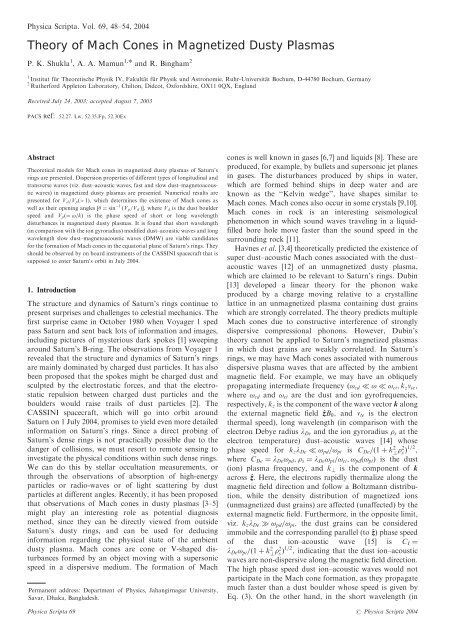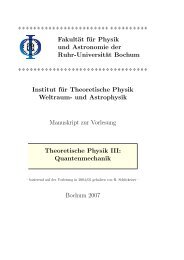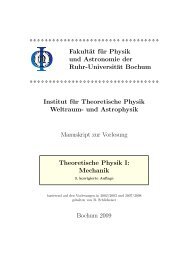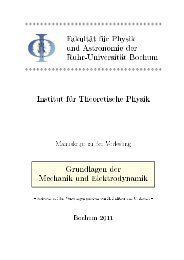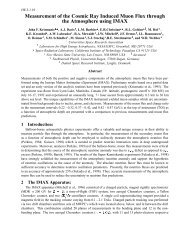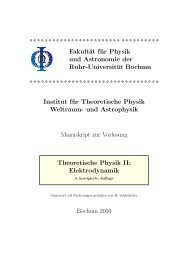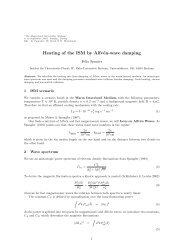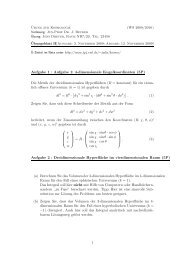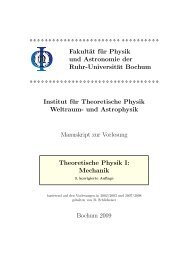PDF FILE - Theoretische Physik IV
PDF FILE - Theoretische Physik IV
PDF FILE - Theoretische Physik IV
You also want an ePaper? Increase the reach of your titles
YUMPU automatically turns print PDFs into web optimized ePapers that Google loves.
Physica Scripta. Vol. 69, 48–54, 2004<br />
Theory of Mach Cones in Magnetized Dusty Plasmas<br />
P. K. Shukla 1 , A. A. Mamun 1, and R. Bingham 2<br />
1 Institut fu¨ r <strong>Theoretische</strong> <strong>Physik</strong> <strong>IV</strong>, Fakultät fu¨ r <strong>Physik</strong> und Astronomie, Ruhr-Universität Bochum, D-44780 Bochum, Germany<br />
2 Rutherford Appleton Laboratory, Chilton, Didcot, Oxfordshire, OX11 0QX, England<br />
Received July 24, 2003; accepted August 7, 2003<br />
PACS Ref: 52.27. Lw, 52.35.Fp, 52.30Ex<br />
Abstract<br />
Theoretical models for Mach cones in magnetized dusty plasmas of Saturn’s<br />
rings are presented. Dispersion properties of different types of longitudinal and<br />
transverse waves (viz. dust–acoustic waves, fast and slow dust–magnetoacoustic<br />
waves) in magnetized dusty plasmas are presented. Numerical results are<br />
presented for V d =V p ð>1Þ; which determines the existence of Mach cones as<br />
well as their opening angles ½ ¼ sin 1 ðV p =V d ÞŠ; where V d is the dust boulder<br />
speed and V p ð¼ !=kÞ is the phase speed of short or long wavelength<br />
disturbances in magnetized dusty plasmas. It is found that short wavelength<br />
(in comparison with the ion gyroradius) modified dust–acoustic waves and long<br />
wavelength slow dust–magnetoacoustic waves (DMW) are viable candidates<br />
for the formation of Mach cones in the equatorial plane of Saturn’s rings. They<br />
should be observed by on board instruments of the CASSINI spacecraft that is<br />
supposed to enter Saturn’s orbit in July 2004.<br />
1. Introduction<br />
The structure and dynamics of Saturn’s rings continue to<br />
present surprises and challenges to celestial mechanics. The<br />
first surprise came in October 1980 when Voyager 1 sped<br />
pass Saturn and sent back lots of information and images,<br />
including pictures of mysterious dark spokes [1] sweeping<br />
around Saturn’s B-ring. The observations from Voyager 1<br />
revealed that the structure and dynamics of Saturn’s rings<br />
are mainly dominated by charged dust particles. It has also<br />
been proposed that the spokes might be charged dust and<br />
sculpted by the electrostatic forces, and that the electrostatic<br />
repulsion between charged dust particles and the<br />
boulders would raise trails of dust particles [2]. The<br />
CASSINI spacecraft, which will go into orbit around<br />
Saturn on 1 July 2004, promises to yield even more detailed<br />
information on Saturn’s rings. Since a direct probing of<br />
Saturn’s dense rings is not practically possible due to the<br />
danger of collisions, we must resort to remote sensing to<br />
investigate the physical conditions within such dense rings.<br />
We can do this by stellar occultation measurements, or<br />
through the observations of absorption of high-energy<br />
particles or radio-waves or of light scattering by dust<br />
particles at different angles. Recently, it has been proposed<br />
that observations of Mach cones in dusty plasmas [3–5]<br />
might play an interesting role as potential diagnosis<br />
method, since they can be directly viewed from outside<br />
Saturn’s dusty rings, and can be used for deducing<br />
information regarding the physical state of the ambient<br />
dusty plasma. Mach cones are cone or V-shaped disturbances<br />
formed by an object moving with a supersonic<br />
speed in a dispersive medium. The formation of Mach<br />
Permanent address: Department of Physics, Jahangirnagar University,<br />
Savar, Dhaka, Bangladesh.<br />
cones is well known in gases [6,7] and liquids [8]. These are<br />
produced, for example, by bullets and supersonic jet planes<br />
in gases. The disturbances produced by ships in water,<br />
which are formed behind ships in deep water and are<br />
known as the ‘‘Kelvin wedge’’, have shapes similar to<br />
Mach cones. Mach cones also occur in some crystals [9,10].<br />
Mach cones in rock is an interesting seismological<br />
phenomenon in which sound waves traveling in a liquidfilled<br />
bore hole move faster than the sound speed in the<br />
surrounding rock [11].<br />
Havnes et al. [3,4] theoretically predicted the existence of<br />
super dust–acoustic Mach cones associated with the dust–<br />
acoustic waves [12] of an unmagnetized dusty plasma,<br />
which are claimed to be relevant to Saturn’s rings. Dubin<br />
[13] developed a linear theory for the phonon wake<br />
produced by a charge moving relative to a crystalline<br />
lattice in an unmagnetized plasma containing dust grains<br />
which are strongly correlated. The theory predicts multiple<br />
Mach cones due to constructive interference of strongly<br />
dispersive compressional phonons. However, Dubin’s<br />
theory cannot be applied to Saturn’s magnetized plasmas<br />
in which dust grains are weakly correlated. In Saturn’s<br />
rings, we may have Mach cones associated with numerous<br />
dispersive plasma waves that are affected by the ambient<br />
magnetic field. For example, we may have an obliquely<br />
propagating intermediate frequency ð! cd ! ! ci ; k z v te ;<br />
where ! cd and ! ci are the dust and ion gyrofrequencies,<br />
respectively, k z is the component of the wave vector k along<br />
the external magnetic field ^zB 0 ; and v te is the electron<br />
thermal speed), long wavelength (in comparison with the<br />
electron Debye radius l De and the ion gyroradius s at the<br />
electron temperature) dust–acoustic waves [14] whose<br />
phase speed for k z l De ! pd =! pi is C De =ð1 þ k 2 ? 2 s Þ1=2 ;<br />
where C De ¼ l De ! pd ; s ¼ l De ! pi =! ci ;! pd ð! pi Þ is the dust<br />
(ion) plasma frequency, and k ? is the component of k<br />
across ^z: Here, the electrons rapidly thermalize along the<br />
magnetic field direction and follow a Boltzmann distribution,<br />
while the density distribution of magnetized ions<br />
(unmagnetized dust grains) are affected (unaffected) by the<br />
external magnetic field. Furthermore, in the opposite limit,<br />
viz. k z l De ! pd =! pi ; the dust grains can be considered<br />
immobile and the corresponding parallel (to ^z) phase speed<br />
of the dust ion–acoustic wave [15] is C I ¼<br />
l De ! pi =ð1 þ k 2 ? 2 s Þ1=2 ; indicating that the dust ion–acoustic<br />
waves are non-dispersive along the magnetic field direction.<br />
The high phase speed dust ion–acoustic waves would not<br />
participate in the Mach cone formation, as they propagate<br />
much faster than a dust boulder whose speed is given by<br />
Eq. (3). On the other hand, in the short wavelength (in<br />
Physica Scripta 69 # Physica Scripta 2004


